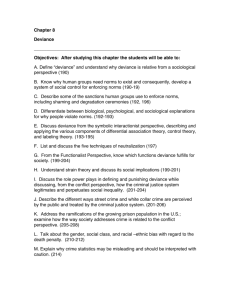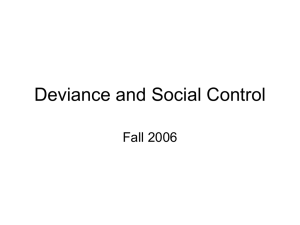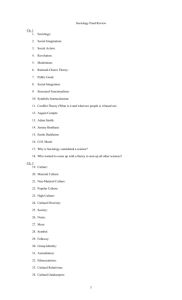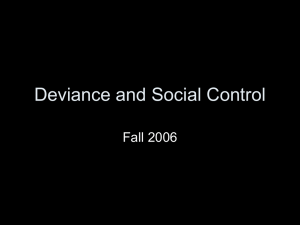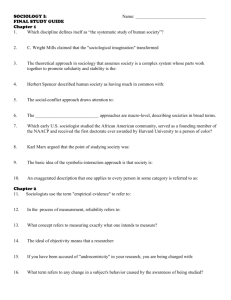Printable Ch. 6 Study Guide
advertisement
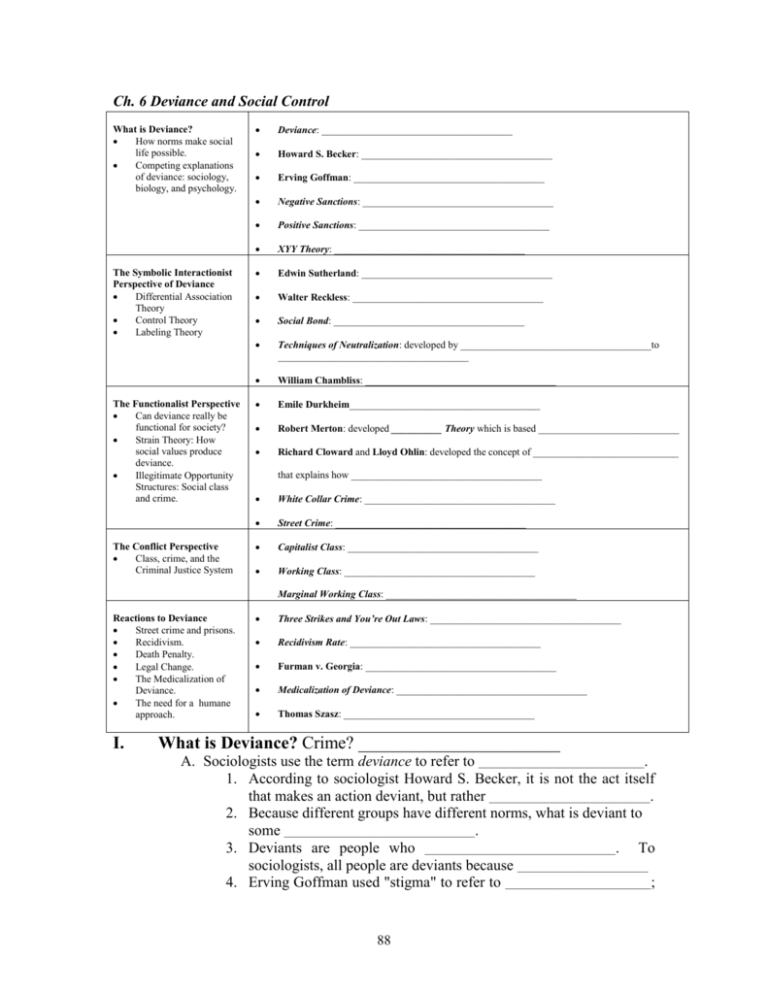
Ch. 6 Deviance and Social Control What is Deviance? How norms make social life possible. Competing explanations of deviance: sociology, biology, and psychology. The Symbolic Interactionist Perspective of Deviance Differential Association Theory Control Theory Labeling Theory The Functionalist Perspective Can deviance really be functional for society? Strain Theory: How social values produce deviance. Illegitimate Opportunity Structures: Social class and crime. The Conflict Perspective Class, crime, and the Criminal Justice System Deviance: ______________________________________ Howard S. Becker: ______________________________________ Erving Goffman: ______________________________________ Negative Sanctions: ______________________________________ Positive Sanctions: ______________________________________ XYY Theory: ______________________________________ Edwin Sutherland: ______________________________________ Walter Reckless: ______________________________________ Social Bond: ______________________________________ Techniques of Neutralization: developed by ______________________________________to ______________________________________ William Chambliss: ______________________________________ Emile Durkheim______________________________________ Robert Merton: developed __________ Theory which is based ____________________________ Richard Cloward and Lloyd Ohlin: developed the concept of _____________________________ that explains how ______________________________________ White Collar Crime: ______________________________________ Street Crime: ______________________________________ Capitalist Class: ______________________________________ Working Class: ______________________________________ Marginal Working Class: ______________________________________ Reactions to Deviance Street crime and prisons. Recidivism. Death Penalty. Legal Change. The Medicalization of Deviance. The need for a humane approach. I. Three Strikes and You’re Out Laws: ______________________________________ Recidivism Rate: ______________________________________ Furman v. Georgia: ______________________________________ Medicalization of Deviance: ______________________________________ Thomas Szasz: ______________________________________ What is Deviance? Crime? _______________________ A. Sociologists use the term deviance to refer to _________________________________. 1. According to sociologist Howard S. Becker, it is not the act itself that makes an action deviant, but rather ________________________________. 2. Because different groups have different norms, what is deviant to some ______________________________________. 3. Deviants are people who ______________________________________. To sociologists, all people are deviants because __________________________ 4. Erving Goffman used "stigma" to refer to _____________________________; 88 Chapter 6 Deviance and Social Control a stigma (e.g., physical deformities, skin color) defines a person's ______________________________________. B. Norms make social life possible by ______________________________________. 1. Without norms, ______________________________________ would exist. 2. The reason deviance is seen as threatening is because it ______________________________________. 3. What is social control? ______________________________________ Is necessary for social life? ______________________________________. C. Deviance and conformity are reinforced or extinguished through ______________________________________. 1. Disapproval of deviance, called negative sanctions, range from ______________________________________ to ______________________________________. 2. What are some examples of positive sanctions________________________ They are used to do what? ______________________________________. D. Comparing Biological, Psychological, and Sociological Explanations 1. Psychologists and sociobiologists explain deviance by looking ______________________________________. Sociologists look ______________________________________. 2. Biological explanations focus on ______________________________________. a. Factors such as intelligence and “XYY” theory. What is the “XYY” theory? 3. Psychiatrist Dorothy Lewis found that _________________________________ ______________________________________ ______________________________________.. 4. Psychological explanations focus on personality disorders (such as what? ______________________________________.). Yet, these do not necessarily result in ______________________________________ ______________________________________ ______________________________________.. 5. Sociological explanations where? ______________________________________.. a. Crime is a violation of what? _________________________________. b. Social influences—such as what? ________________________________. —may “recruit” some people to ______________________________________. II. The Symbolic Interaction Perspective A. Differential association is whose term? ______________________________________. It indicates that those who associate with groups oriented toward deviant activities ______________________________________ ______________________________________. ______________________________________ ______________________________________.. 1. The key to differential association is ____________________________________ _____________________________________ ______________________________________. Some groups teach members to ______________________________________. Give examples. _______________________________________________________ ______________________________________ ______________________________________. 2. Symbolic interactionists stress that people are ______________________________________ ______________________________________ ______________________________________ ______________________________________.. B. Control Theory 1. According to control theory ______________________________________ 89 ______________________________________ ______________________________________. It was suggested by ______________________________________. 2. Inner controls are ______________________________________ ______________________________________ ______________________________________. Sociologist Travis ______________________________________noted that strong bonds to society ______________________________________ ______________________________________ ______________________________________. C. Labeling theory is the view that the labels people are given affect ____________________________________________________________________________ ____________________________________________________________________________ . 1. ______________________________________use the term "techniques of neutralization" to describe ______________________________________ ______________________________________. These are (1) ______________________________________; (2) ______________________________________; (3______________________________________; (4) ______________________________________; and (5______________________________________. 2. Sometimes an individual's deviant acts begin _________________________ ____________________________________________________________________________. 3. Most people resist being labeled deviant, but some ____________________________________________________________________________ ____________________________________________________________________________. 4. William J. Chambliss's study of the Saints (______________________________________) and the Roughnecks (______________________________________) provides an excellent illustration of ______________________________________. a. Labels given to people affect how others ____________________ _____________________________________________________________________ _____________________________________________________________________. b. The study showed ______________________________________________ __________________________________________________________________. III. The Functionalist Perspective A. Emile Durkheim stated that deviance, including ________, is _________ ____________________________________________________________________________ . 1. Deviance clarifies ______________________________________ (a group's ideas about how people should act and think) and affirms ________________. 2. Deviance promotes ______________________________________ (by ______________________________________). 3. Deviance promotes ______________________________________ (if boundary violations gain enough support, ______________________________________). B. Robert Merton developed ______________________________________to analyze what happens when _________________________________________________________________ ____________________________________________________________________________. 1. Merton used "______________________________________" (Durkheim's term) to refer ______________________________________________________________________ ____________________________________________________________________________. 90 Chapter 6 Deviance and Social Control 2. The most common reaction to cultural goals and institutionalized means is ______________________________________. Explain: ____________________________________________________________________________ 3. He identified _____ types of deviant responses to anomie: ______________________________________ ______________________________________; ______________________________________ ______________________________________; ______________________________________ ______________________________________; and ______________________________________ ____________________________________. Give examples of each. 4. According to ________ theory, deviants are _______________________________ ____________________________________________________________________________. C. Illegitimate Opportunity Theory 1. Social classes have distinct styles of ___________________________________ ______________________________________ ______________________________________. 2. Illegitimate opportunity structures are _________________________ 3. According to sociologists Richard ________and Lloyd ________, they may result ____________________________________________________________. 4. For the urban poor, there are opportunities ___________________________. ____________________________________________________________________________ The “hustler” is a role model because _________________________________ ____________________________________________________________________________. 5. What is white-collar crime? ______________________________________ ____________________________________________________________________________ They result from ___________________________________________________________ ____________________________________________________________________________. D. IV. a. Such crimes exist in _________ numbers than commonly perceived, and can be very ___________________________________. b. They can involve __________ harm and sometimes ________; for instance, unsafe working conditions kill about ____________ Americans each year—about _____ times the number of people killed by street crime. There have been some recent changes in the nature of white-collar crime. 1. A major change is ______________________________________. 2. As women have become more involved in the professions and the corporate world, they too have been enticed by ______________________ ______________________________________. 3. Today nearly as many women as men are arrested for _____________ ______________________________________. The Conflict Perspective A. The state's machinery of social control represents ____________________________ 1. This group determines ___________________________________ criminal justice system _______________________________. B. The law is an instrument of ______________________________________ . 1. It is a tool designed to ______________________________________ ____________________________________________________________________________. 2. When members of the working class get out of line, they are ___________ ______________________________________ ______________________________________ 3. The criminal justice system directs its energies against 91 ____________________________________________________________________________ 4. The publicity given to this level of white collar crime helps to stabilize the system by ______________________________________. C. Law enforcement is a cultural device through which capitalists ______________________________________ ______________________________________ . V. Reactions to Deviance Capital punishment? A. Degradation ceremonies are rituals designed to _____________________ _________________________________________ ______________________________________. 1. Typically, what happens? _____________________ ___________ 2. When pronounced guilty, _____________________ ___________. 3. Such proceedings signal what? _____________________ B. Imprisonment is an increasingly popular reaction to crime but fails to _____________________ _____________________ ____________________ 1. What is the recidivism rate? _____________________ in the US runs as high as 85-90 %, & those given probation do no better. 2. There is disagreement within U.S. society as to why criminals should be imprisoned. 3. Different reasons for imprisonment include retribution - _____________________ ____________________; deterrence-____________________________ ___________________ rehabilitation ________________________ ___________________ incapacitation ________________________ ___________________ Medicalization of deviance views deviance as ________________ 1. Thomas _______ argues that mental illness is simply _________: some forms of "mental" illnesses have organic causes such as _____________________________________________________ while others are responses to ______________________________. 2. Some sociologists find Szasz's analysis refreshing because it indicates that _____________________________, and not ____________________, underlie bizarre behaviors. 3. Being mentally ill can sometimes lead to other problems like homelessness; but being homeless can lead to ________________ _____________________________________________________ D. With deviance inevitable, 1 measure of a society is ____________ ________________ ________________ E. The larger issues are _______________________________ ________________ Capital punishment capitalist class control theory control theory control theory crime criminal justice system cultural goals cultural goals differential association genetic predisposition hate crime illegitimate opportunity structure institutionalized means marginal working class medicalization of deviance personality disorders labeling theory recidivism rate social control social order stigma working class strain theory street crime techniques of neutralization white-collar crime or corporate crime positive sanction negative sanction 92


